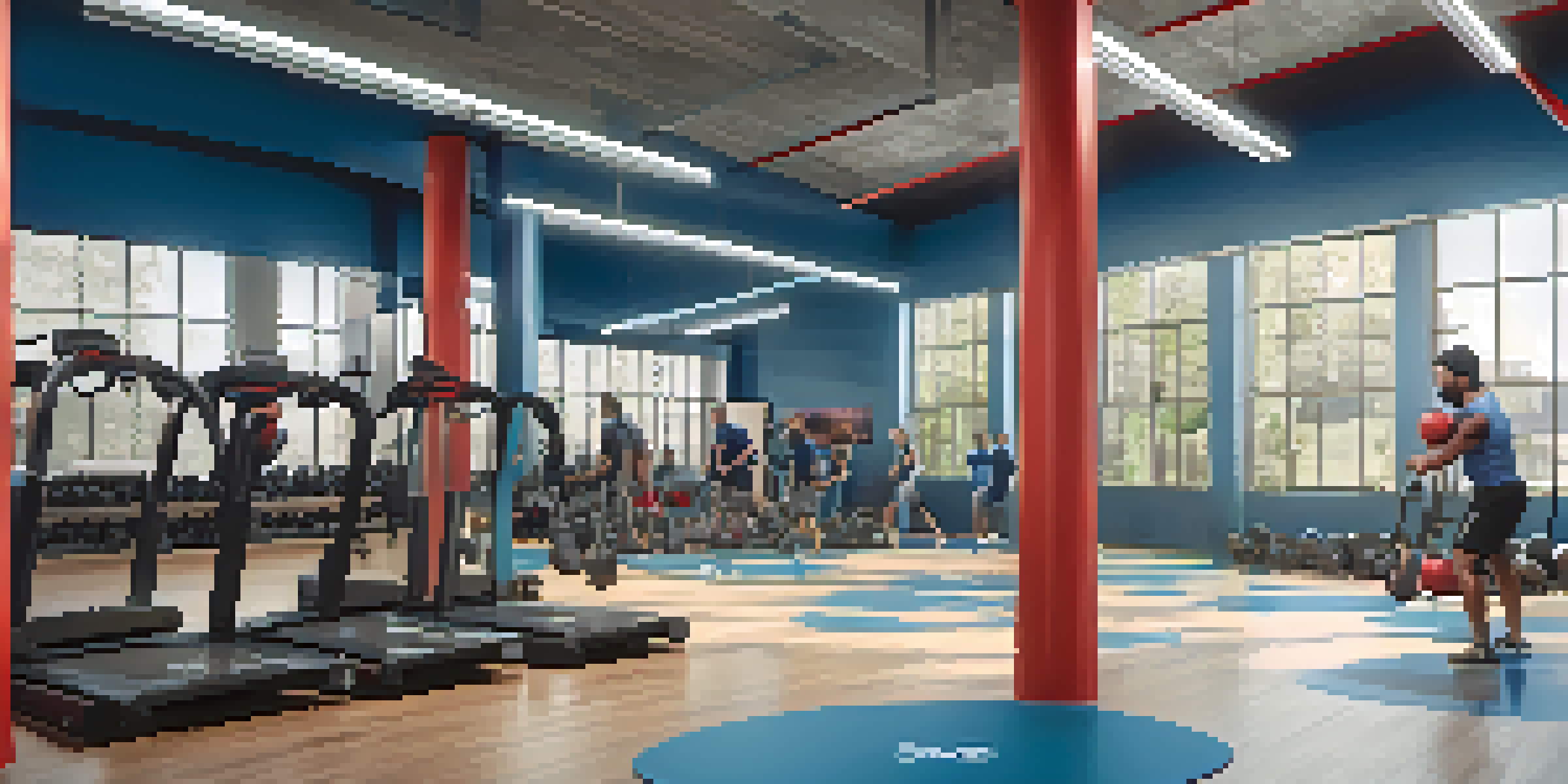Integrating Cross-Functional Training for Bodybuilding Gains

Understanding Cross-Functional Training in Bodybuilding
Cross-functional training involves diverse exercise modalities that work different muscle groups. Unlike traditional bodybuilding, which often focuses on isolated movements, this approach enhances overall strength and functional fitness. Think of it as a way to build a well-rounded physique while improving performance in everyday activities.
The strength of the team is each individual member. The strength of each member is the team.
For instance, incorporating activities like swimming or cycling can engage your core and improve cardiovascular endurance. This not only supports your bodybuilding routine but also helps prevent injuries by promoting balance and coordination. Ultimately, cross-functional training isn't just an add-on; it's a game changer in how you approach your fitness journey.
By understanding the principles of cross-functional training, bodybuilders can design programs that not only target muscle hypertrophy but also enhance athletic performance. This holistic approach can lead to impressive gains that traditional methods might not achieve alone.
Benefits of Cross-Functional Training for Muscle Growth
One of the primary benefits of cross-functional training is its ability to stimulate muscle growth through varied stimuli. When you engage in different types of workouts, your muscles adapt in unique ways, which can lead to enhanced hypertrophy. This principle is rooted in the concept of progressive overload, where muscles grow stronger as they're challenged by new demands.

For example, if you regularly perform squats, adding kettlebell swings to your routine can target similar muscles while introducing new movements. This combination not only keeps workouts fresh and exciting but also promotes muscle recruitment and development across various muscle fibers. As a result, your gains can become more pronounced.
Cross-Functional Training Enhances Fitness
This training approach incorporates diverse exercises that improve overall strength and functional fitness beyond traditional bodybuilding.
Additionally, by diversifying your training, you may find that certain muscle groups respond better to cross-training than traditional bodybuilding alone. This adaptability can lead to a more balanced physique, reducing the risk of overuse injuries and plateaus in your progress.
Incorporating Functional Movements into Your Routine
To effectively integrate cross-functional training, start by identifying movements that complement your bodybuilding workouts. Functional movements like deadlifts, push-ups, and pull-ups not only build strength but also improve your overall stability and mobility. These exercises often engage multiple muscle groups simultaneously, making them perfect for building a solid foundation.
Fitness is not about being better than someone else. It's about being better than you used to be.
Consider creating a weekly schedule that alternates between your bodybuilding workouts and functional training sessions. For example, you might dedicate two days to traditional lifting and two days to circuit training that incorporates functional movements. This balance allows your muscles to recover while still challenging them in new ways.
Moreover, pay attention to how these functional movements enhance your bodybuilding performance. You'll likely notice improvements in your lifting technique, endurance, and overall strength, leading to better results in the long run.
The Role of Cardio in Cross-Functional Bodybuilding
While bodybuilding typically emphasizes weight training, integrating cardiovascular exercises into your routine can significantly enhance your results. Cardio helps improve your heart health and endurance, allowing you to train harder and longer. This increased stamina can be especially beneficial during those grueling bodybuilding sessions when fatigue might otherwise set in.
For instance, incorporating high-intensity interval training (HIIT) can elevate your heart rate while also building lean muscle. A quick 20-minute HIIT session can enhance your metabolic rate, helping to burn fat while preserving muscle mass. This balance is crucial for bodybuilders aiming to achieve that coveted aesthetic look.
Diverse Workouts Stimulate Muscle Growth
Engaging in varied workout modalities leads to unique muscle adaptations and can promote enhanced hypertrophy.
In addition to physical benefits, cardio can also aid in recovery by promoting blood circulation. This means better nutrient delivery to your muscles post-workout, which is essential for growth and recovery. So, don’t shy away from that treadmill or rowing machine; embrace it as a valuable part of your bodybuilding journey.
Nutrition Strategies for Cross-Functional Training
Nutrition plays a pivotal role in optimizing the benefits of cross-functional training. As you diversify your workouts, your body will require a well-rounded diet to fuel recovery and growth. Focus on incorporating a mix of macronutrients: proteins for muscle repair, carbohydrates for energy, and healthy fats for overall health.
For instance, post-workout meals that combine lean protein with complex carbs can help replenish glycogen stores and promote muscle recovery. Think grilled chicken with quinoa and steamed vegetables – a delicious and effective way to nourish your body. Hydration is equally important, as it supports performance and recovery.
Additionally, consider timing your meals around your workouts to maximize energy and recovery. Eating a balanced meal or snack an hour before training can provide the fuel needed for intense sessions, while a protein-rich meal afterward can facilitate muscle repair. Staying mindful of your nutrition can truly amplify the gains from your cross-functional training.
Tracking Progress in Cross-Functional Bodybuilding
Monitoring your progress is essential when integrating cross-functional training into your bodybuilding routine. Keeping a journal or using a fitness app can help track not only your weights and repetitions but also your performance in different functional exercises. This data can provide valuable insights into your development and assist in adjusting your training plan as necessary.
Consider setting specific, measurable goals for both your bodybuilding and functional training. Whether it's increasing your deadlift weight, mastering a new movement, or improving your cardiovascular endurance, having clear objectives can keep you motivated. Celebrate your achievements along the way, no matter how small; they all contribute to your overall progress.
Nutrition Supports Cross-Training Gains
A well-rounded diet, focusing on macronutrients and meal timing, is crucial for optimizing recovery and performance in cross-functional training.
Additionally, periodic assessments, like fitness tests or body composition analysis, can help gauge your improvements. By taking a comprehensive approach to tracking your progress, you’ll be better equipped to make informed decisions about your training, ensuring that you continue to see results over time.
Conclusion: Embrace Cross-Functional Training for Optimal Gains
Incorporating cross-functional training into your bodybuilding regimen can open the door to new levels of strength and fitness. By diversifying your workouts, you not only stimulate muscle growth but also enhance functional strength, endurance, and overall health. It's about creating a balanced approach that supports both your bodybuilding goals and daily life.
Remember to embrace the journey and be open to experimenting with different training styles and exercises. The key is to listen to your body and adjust your routine based on what feels right for you. This adaptability can lead to sustainable progress and a more enjoyable fitness experience.

Ultimately, cross-functional training is not just an addition to your routine; it's a mindset shift that can transform how you approach your workouts. So, lace up those sneakers, grab those weights, and get ready to elevate your bodybuilding game!